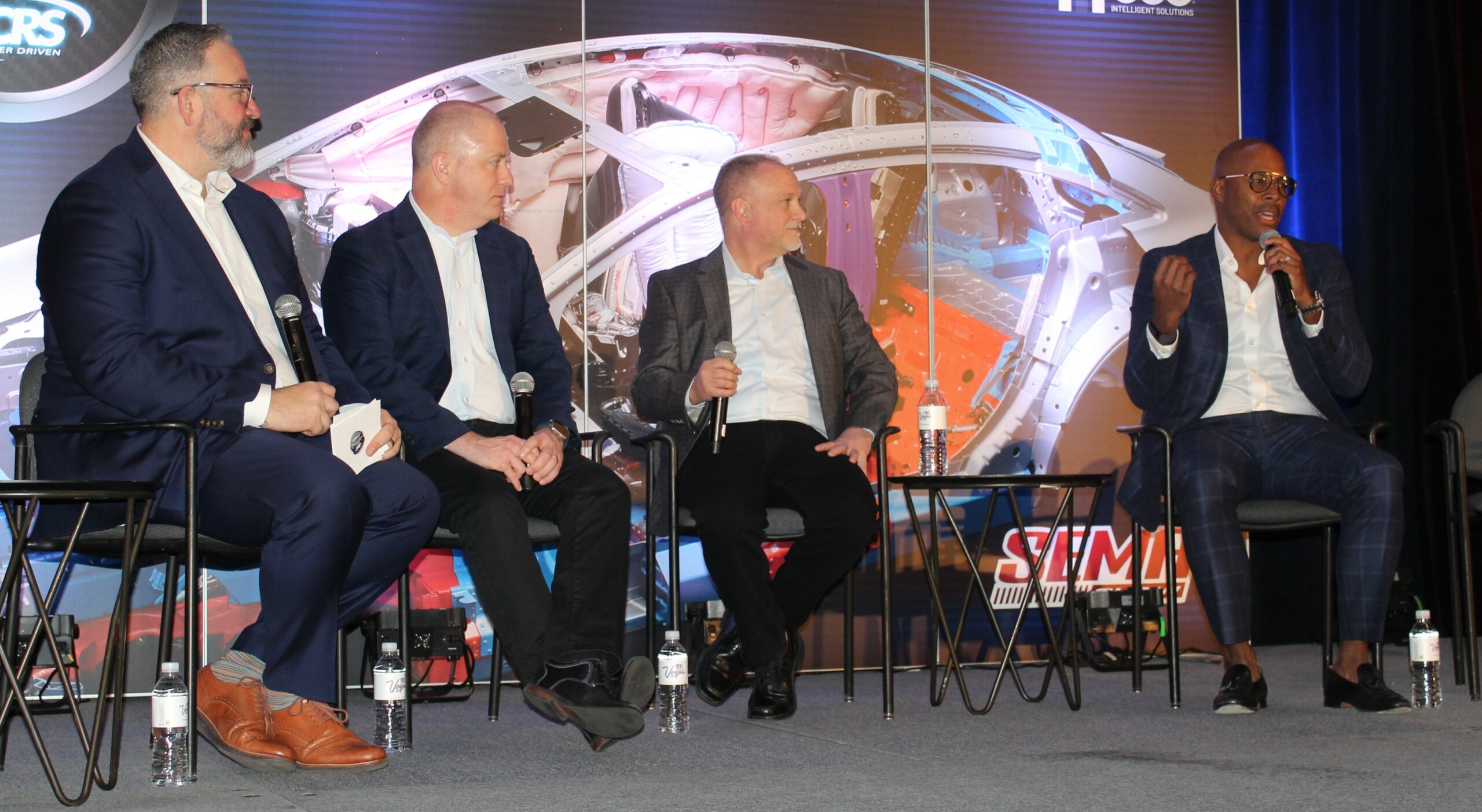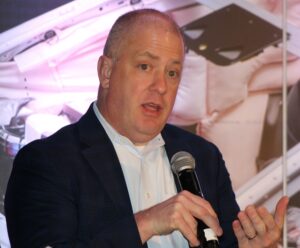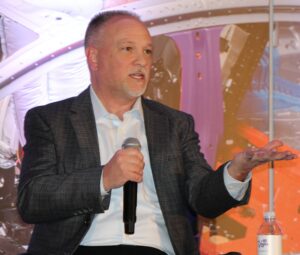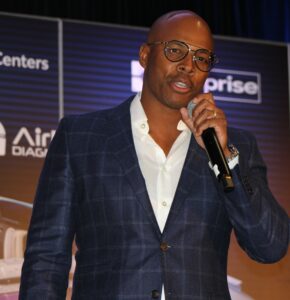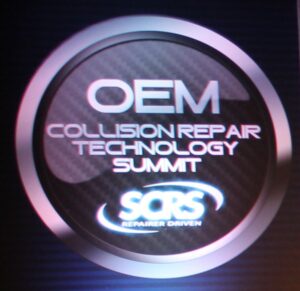
OEM insurance execs say their products save time, improve claims process for all involved
By onInsurance
Insurance executives with General Motors, Rivian, and Toyota shared on Thursday that the goals they have in offering insurance to their customers are not only to protect their brand and keep customers happy but also to provide a better claims experience for all involved, including payment to repairers for the use of OEM parts and repair procedures.
Andrew Rose, OnStar Insurance president; Mike Slattery, Rivian head of insurance, and Robert Spencer, Toyota Insurance president and COO, shared how insurance through their OEMs works during one of three Society of Collision Repair Specialists (SCRS) OEM Collision Repair Technology Summit sessions.
They all agreed that they didn’t get into the insurance business to be in the insurance business but to keep customers happy with their brands.
SCRS Executive Director Aaron Schulenburg started off the session by saying that the challenges repair facilities run into is a difference in perception and expectation and what consumer experience should look like.
“As a collision center who’s super committed to using the right parts and the right tools and the right equipment and finding the right procedures, sometimes [we] run into this roadblock in that consumer experience,” he said. “What this represents is a potential shift where everybody is working towards common goals to have a similar consumer experience for a similar outcome.”
Rose said GM’s goal is to reduce, and eventually eliminate, collisions through the use of advanced driver assistance systems (ADAS). When collisions occur, he and Slattery said customers and repair facilities benefit from OEMs’ direct access to vehicle telematics. For example, g-force during a collision can help predict damage as well as what the cause was, not only through data but also camera footage.
Rose noted that 90% of the 1.2 million crashes people die in worldwide are caused by human error. He said GM wants to add value to its customers’ journey by incentivizing their good driving behaviors much like tracking steps on a smartwatch.
OEMs have access to consumers when they’re shopping for cars, when they’re buying cars, when they’re getting their car serviced when they’re in their vehicles, and when they’re interacting with the screens in their vehicles and their mobile apps, putting OEMs at an advantage to not have to aggressively advertise like traditional carriers, Rose added.
“That money can go back into your pocket — more value back to the safest drivers,” he said. “If you get into a claim when an accident does happen, not only can we assist, but we can use our technology to help triage the accident scene… We can dispatch first responders. We can tell them what part of the car they need to go to first because it has the greatest amount of damage. Thankfully, the vast majority of accidents aren’t that severe, which means the pain they feel is us. You and me, the claims process, we can improve if not, fix that, with this data.”
For example, based on sensor data, GM will know what may be broken or damaged and immediately order parts and schedule the repair to reduce cycle time and supplements.
“All of a sudden, everybody wins,” he said. “The consumer gets their car back earlier.”
In the case of a total loss, the customer would have a new or used replacement vehicle within 24 hours of the collision, Rose added.
Rivian is working on integrating its insurance into part of the consumer’s digital vehicle purchase process in addition to financing and trade-in options.
“This invites people into this ecosystem so that we can start giving them a better repair experience and a better insurance and claims experience,” Slattery said. “They want to make sure that if they buy our insurance that their $100,000 pickup or their SUV is going to be repaired and given back to them in the best shape. We have fast-track access and, although it’s not a part of the traditional insurance product, it brings that peace of mind that if their vehicle does get totaled and they need to get another one, they’re not waiting another year to get a vehicle.”
Rivian’s insurance branch works with collision repair, ADAS, and vehicle design teams to make sure that when the vehicles are designed they’re designed to be repaired, he added.
“People are looking at what are the better ways, the more affordable ways, the faster ways to repair vehicles,” Slattery said. “This helps everybody. Consumers are happier, insurance is happier, repair networks are happier… if we can work together to make the process better and more efficient.”
Spencer said Toyota’s insurance team puts an emphasis on educating consumers and repair centers on __ and advocating for consumers’ vehicles to be safely and properly repaired, including the type of insurance policy consumers should have and why certain things are important.
“The OEM endorsement is a big part of that,” he said. “An OEM endorsement works by helping to guarantee that only original equipment manufacturer parts and materials will be used when making covered repairs to your vehicles. What does this all mean for you? It means better repairs, faster repairs, and it means happier customers… a Toyota Auto insurance policy with the OEM endorsement [means] you’re part of the guaranteed repair program.”
Spencer shared that he looked for online reviews of collision repair service and found that customers are willing to pay more, if they have to, for OEM parts because they want their vehicles returned to their original factory condition.
One review read, “I paid real money into my insurance for years to get something that I’m just not proud of anymore. I only wish my insurance would have given me the option to pay more for a new bumper with repairs that would have made my car feel and sound like the solid vehicle I purchased before the hit-and-run.”
But unfortunately, most consumers don’t read their insurance policies until after they submit a claim, which is where collision repair facilities can help educate their customers, Spencer said. When customers are dissatisfied with their insurance, repairers can point them to OEM insurance, within the states where it’s currently available, to have a better claims experience the next time, he said.
Rose added, “You [repairer] are the single best advocate, period. You are the expert in that moment and so, from that standpoint, if you are being forced to deliver an experience that you don’t like, and the customer doesn’t like, tell them how to get a better experience.”
One difference between the three OEM insurance branches is that GM employs its own service and sales agents and adjusters while Toyota and Rivian provide coverage through partner insurance carriers.
However, Toyota and Rivian said the certified repair programs they offer can sort out insurance and repair center friction on the front end before reaching the third-party carriers.
In response to an audience member’s question on how OEM insurance providers handle payment for pre- and post-scans, which repairers often receive pushback from carriers on, Rose said that’s the benefit of having insurers at OEMs.
“I can take that comment back and go, ‘Why do we do that, if we actually want you to do this every time? Why do we say recommend?’ I may learn that there’s a very good reason why we say that or they may go, ‘Alright, we’ll change it,'” he said. “That’s the benefit of having an insurer inside of an OEM.”
Images
Featured image: The SCRS OEM Collision Repair Technology Summit logo. (Lurah Lowery/Repairer Driven News)
(From left) SCRS Executive Director Aaron Schulenburg, OnStar Insurance President Andrew Rose, Rivian Head of Insurance Mike Slattery, and Toyota Insurance President and COO Robert Spencer discuss OEM insurance during the 2023 OEM Collision Repair Technology Summit in Las Vegas on Nov. 2. (Lurah Lowery/Repairer Driven News)

